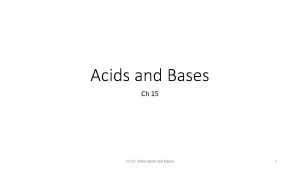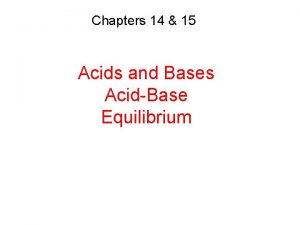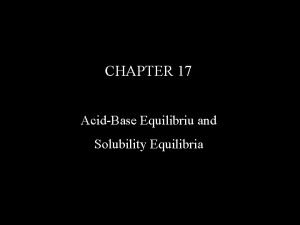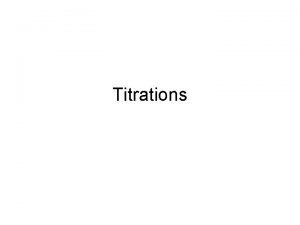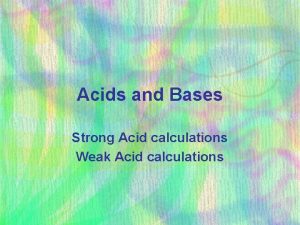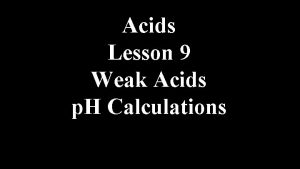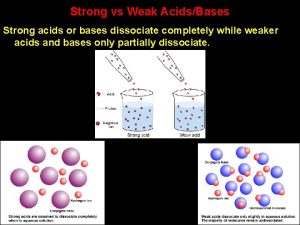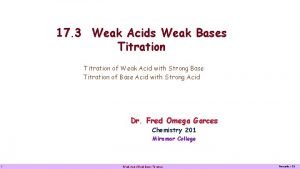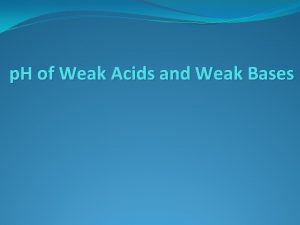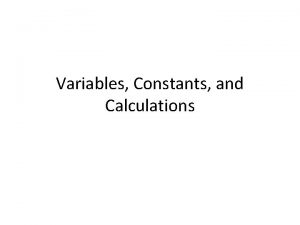Strong Acids Weak Acids Calculations Strong Acids Recall














- Slides: 14

Strong Acids & Weak Acids Calculations

Strong Acids • Recall that strong acids completely dissociate • Therefore:

Examples of Strong Acids • • • There are relatively few strong acids: hydrochloric - HCl hydrobromic acid – HBr hydroiodic acid - HI sulphuric acid - H 2 SO 4 nitric acid – HNO 3 phosporic acid H 3 PO 4 perchloric acid – HCl. O 4 are the most familiar (these are the ones you are expected to know)

Strong Acid Concentrations • Since strong acids completely dissociate we can use Kw= 1. 00 x 10 -14 to calculate concentrations of ions dissociated in water • Example: Calculate the concentration of hydroxide ions in a 0. 15 mol/L solution of hydrochloric acid at 25 °C.

Strong Acid’s p. H Calculation • We use the same assumption for calculating p. H. • Example what is the p. H of a HCl solution where 0. 15 mol of HCl is dissolved in 1. 0 L of water? • = 0. 15 mol/L • p. H = -log (0. 15) = 0. 82

Strong Acid’s p. H Calculation • What is the p. OH of the same solution? • Recall p. H + p. OH = 14 • p. OH = 14 – 0. 83 = 13. 17 – We’ll just disregard sig figs for this one

Weak Acids: Incomplete Ionization • Weak acids do not ionize completely, they form a mixture of dissolved acid and dissociated acid with the general form: • e. g. acetic acid

Percent Ionization: • The degree of ionization can be expressed as a percent: • Thus knowing the p. H = -log[H+] of a solution and how much was dissolved you can determine %ionization.

Percent Ionization: • Example: The p. H of a 0. 10 mol/L acetic acid solution is 2. 89. Calculate the percent ionization of acetic acid. • [H+] = 10 -p. H = 10 -2. 89 = 1. 29 x 10 -3 mol/L

Ionization as an Equilibrium • As discussed acid-base chemistry can be understood in terms of equilibria • Ka = acid ionization constant is the equilibrium constant for acid dissociation (likewise Kb for base dissociation)

Finding Ka • Ka can be found using percent ionization. • Example: Calculate the acid ionization constant of acetic acid if a 0. 10 mol / L solution at equilibrium at 25°C has a percent ionization of 1. 3%.

Ka used to calculate p. H • Ka can be used to calculate p. H in aqueous acid solutions. Assume 25 °C unless told otherwise. • Example: Calculate the hydrogen ion concentration and the p. H of a 0. 10 mol / L acetic acid solution.

p. H to Ka • Likewise p. H can be used to calculate Ka • Example: You measure the p. H of a 0. 10 mol/L hypochlorous acid (HOCl ) solution and find it to be 4. 23. What is the Ka for hypochlorous acid?

Likewise for Bases • All of these calculations are applicable to strong bases and weak bases but we will not be covering them.
 Dilute strong acid
Dilute strong acid Strong vs weak acids
Strong vs weak acids Weak acid weak base titration
Weak acid weak base titration Acids and bases
Acids and bases How to remember strong acids and strong bases
How to remember strong acids and strong bases Be strong be strong be strong in the lord
Be strong be strong be strong in the lord Types of connections in steel structures
Types of connections in steel structures Weak acid and weak base reaction
Weak acid and weak base reaction Weak acid and weak base
Weak acid and weak base Strong ai vs weak ai
Strong ai vs weak ai H2so4 strong or weak
H2so4 strong or weak Ph weak acid strong base
Ph weak acid strong base I rest on his unchanging grace
I rest on his unchanging grace Strong ai vs weak ai
Strong ai vs weak ai Strong weak syllables
Strong weak syllables



